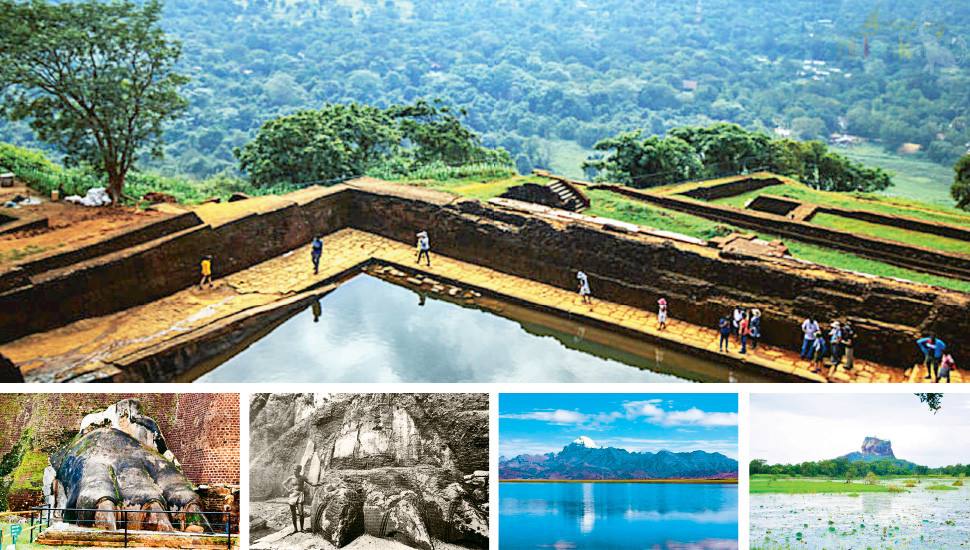In Search of the Lion at Sigiriya – Part 3

In Search of the Lion at Sigiriya by Ama H.Vanniarachchy
Part 3
“The subject matter of Archaeology is threefold—the Oral, the Written, and the Monumental.”
– Sir Charles Thomas Newton
We witnessed great conspiracies and tragedies surrounding the Sinhala monarchy of Anuradhapura. Sigiriya emerged amidst these turbulences under the powerful rule of Kasyapa, the God-King. Sri Lanka being home to many hundreds of great warrior kings and Buddhist rulers, Kasyapa still remains amongstst the most well-known and beloved monarchs. His tragic fate and his great masterpiece Sigiriya, secures his place as such.
As we have now witnessed the great conspiracies that happened back in the days of Kasyapa and his tragic death, let us travel back to Sigiriya to know more about the Lion of Sigiriya.
Kasyapa as an ideal Buddhist ruler…
Kasyapa was a great patron of Buddhism, say the chronicles. He renovated the Isurumuniya Temple and donated land and a large number of villages to the temple. He enlarged the temple and renamed it as Bo-Upulvan-Kasup Giri Vihara, which means ‘Bodhi, Uppalavanna, and Kasyapa’s temple.’ Bodhi and Uppalavanna were Kasyapa’s daughters. Inscriptions prove the existence of a vihara of this name at the premises.
He also built a monastery close to the gardens at Sigiriya and named it as Bo-Upulvan-Kasup Vihara. Although the chronicle portrays Kasyapa to be someone who commited patricide, it also portrays him as a religious person who greatly practiced and followed the Buddha’s teachings. The chronicles say that the number of image houses and alms-houses constructed by Kasyapa are uncountable.
Bodhi and Uppalavanna; beloved daughters of the king
It is believed that of the many frescoes at Sigiriya, the blue damsels and the golden damsels, represent the two beloved daughters of Kasyapa; Bodhi (the golden one) and Uppalavanna (the blue lotus-coloured one).
However we do not know the fate of these young princesses, the beloved daughters of Kasyapa, after his sudden death. As Prof. Senarath Paranavithana says, the king’s young son, six-year-old Dhatusena fled to Pundra kingdom and lived there till his death. Yet he does not mention these two princesses. Lack of historical records and archaeological records restricts us from assuming about the fate of Bodhi and Uppalavanna.
Sigiriya as the Alakamandawa
According to The Story of Sigiri by Prof. Paranavithana, Kasyapa was assassinated at the Plateau of Red Arsenic at Sigiriya. This Plateau of Red Arsenic is known to be the area in front of the lion’s paws. It is believed that Kuvera’s abode, the Alakamandawa, had such a feature.
Kasyapa after ascending to the throne, built his abode in Sigiriya. According to many scholars his model was Alakamandawa or the abode of the mythological god-king Kuvera, who is also known to be the god of wealth. For decades scholars have had many arguments regarding the concept of Sigiriya. However, the concept of Alakamandawa is the most suitable one when comparing the features of this great masterpiece. Kuvera’s abode was located on Mount Kailash. Sigiriya rock is the Kailash. As the abode was on the summit of Kailash, Kasyapa’s royal palace was on the summit. Sigiri Wewa represents Lake Manasa. The beautiful gardens of Alakamandawa were the pleasure gardens at Sigiriya. The many caves and rock shelters at the foot of Kailash are similar to the caves and rock shelters at Sigiriya.
The entrance to Kuvera’s abode was located in the northern direction. Similarly, the entrance to the palace of Sigiri is the Northern Gate, which still remains undiscovered. It is a known fact that although we use the western direction to enter into the royal gardens and then ascend the rock, the ancient main gateway into the palace was located in the northern direction. It is at this North Gate that Kasyapa built a gigantic lion, and the main doorway to the palace. It should be noted that the lion in ancient Sinhalese art represented the northern direction.
Now as we have ascended the Lions’ Paw and the Plateau of Red Arsenic or the Raktha-gal-thalawa, we shall rest here for a while as the greatest mystery of Sigiriya lies here. The Lion’s Paws, the lost gigantic lion face, and the plateau where Kasyapa lay dead…
Here lie the mysteries of the Northern Gateway…
The Lion
We have no reason to reject or doubt about the existence of a giant lion’s face built by Kasyapa. This is the only remaining Lion doorway at Sigiriya out of the many lion faced doorways mentioned in the chronicles. A couple of scholars and artists in recent times have attempted to recreate the Lion at Sigiriya. Here we present to you some of the finest examples of seated lions that we encountered among the carvings at Anuradhapura as a comparison and a visual aid.
(In a previous heritage feature story titled as In Search of the Lion at Sigiriya Part I, we have introduced the Lion’s Paw.)
Folklore comes in aid when historical and archaeological data is missing. There have been stories about a hidden palace beneath the Lion’s face gateway and this Lion’s face damaged by H.C.P. Bell and the doorway being sealed. Relying on folklore is like swimming in unknown waters. Yet this is only an attempt to fill in some of the missing parts of the jigsaw puzzle.
Listening to the villagers…
We will present to you some folklore that is popular among the villagers in the vicinity of Sigiriya. It is true that the reliability of folklore, compared to historical documents and archaeological evidence, is less. However, these stories are not more than 11 decades older from the time Bell worked at Sigiriya and those stories were told and passed to the next generation by eyewitnesses, some actually having worked with Bell. Next time you visit Sigiriya make sure to walk around in the surrounding villages, meet the people and ask about what they know regarding the palace of Sigiriya and the Lion. These many stories retold by villagers were collected by the writer during 2006-2007.
Villagers say that during the time of Bell, they had to use ropes to climb up and a large number of labourers were brought to work at Sigiriya from Jaffna.
A hidden palace
Hearing stories about a hidden palace with many riches, Bell had ascended there with his people and had excavated the entrance. Stopped by black wasps, Bell had commanded the entrance to be sealed and had covered up the excavations. The gem studded crown of Kasyapa is believed to be inside this palace along with many more riches including precious stones. It is also believed that Bell had stolen some of the riches and sent them back to his country.
The doorway sealed by Bell
The entrance we see today at the Lion’s Paw was constructed by Bell using cement and iron bars after excavating the original entrance which led into the royal palace. He had sealed the doorway with cement. The brick work around the Lion’s Paw you see today was later constructed by Bell after he had broken the stone doorway. Labourers from Jaffna entered the palace through this stone door. Not a single villager did so, out of fear. While Bell and his people were snatching away the many riches they saw, giant black wasps attacked them and many died. It is also said that an ancient stairway located towards the left of the Lion’s paws was closed by Bell.
Bell and the Lion
Another story goes on to say that the bright blue sapphires that were studded in the eyes of the Lion were intact when Bell first encountered it. Driven by greed, Bell had snatched them. Also it is said that Bell destroyed the Lion’s face. He damaged it severely to find a doorway into the hidden palace. When the Lion’s face was destroyed many people died as it appeared to be a curse.
Mysterious guardians of treasures Bewildering black wasps
Every time Bell and his people excavated the entrance to the palace, at the Lions’ Paw, they were attacked by mysterious black wasps appearing out of nowhere. Once when Bell was excavating near the gigantic Lion, he was stopped by huge black wasps. Many people died when the wasps attacked. Attacked by the wasps and the Bhahirava, Bell fled away and never returned to Sigiriya. It is believed by locals that these black wasps are protectors of Sigiriya and they are the army of Kasyapa.
Bhahirava; protector of riches
It is believed that a Bhahirava protects the riches at Kasyapa’s palace and he had once stopped Bell from entering the ancient palace.
These are stories. Not historical records nor archaeological evidences. Just stories told and retold by villagers, some of them being eyewitnesses of Bell’s work. Some of these villagers are the second generation of those who actually worked with Bell at Sigiriya.
We do not know the truth behind these stories. Yet, we would like to focus on a few interesting archaeological evidences. The marks of drip-ledges above the Lion’s Paws is a reason to raise many doubts. Drip-ledges are cut marks at ancient caves that were used as dwellings. Drip-ledges are not marked at places that are unutilised or if there is no cave beneath it.
Old photographs of Bell show a stairway, situated towards the left of the Lion’s Paws. Also, the fact that ascending the summit of the rock on a daily basis is not very practical. More than one karkataka yanthra (elevator or a lift) must have been in use for sure.
To be continued…
“The limitations of archaeology are galling. It collects phenomena, but hardly ever can isolate them so as to interpret scientifically; it can frame any number of hypotheses, but rarely, if ever, scientifically prove.”
– David George Hogarth
The original article was first published on
https://ceylontoday.lk/news/in-search-of-the-lion-at-sigiriya-2
Uncategorized, Kashyapa, Sigiriya, Sri Lankan archaeology, SRI LANKAN HISTORY
